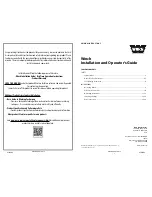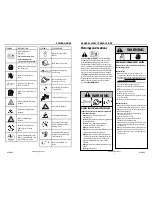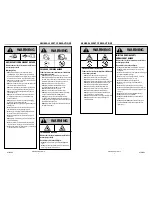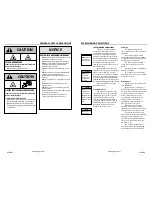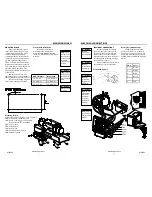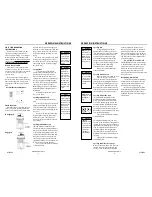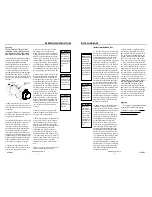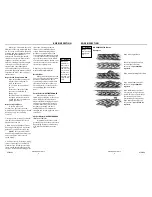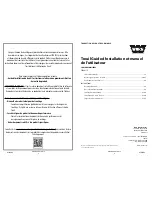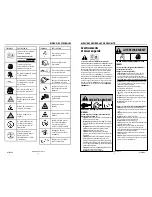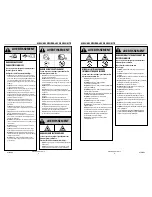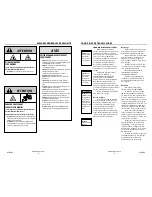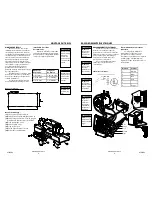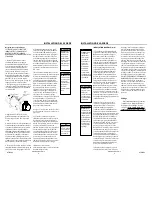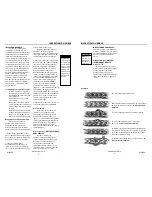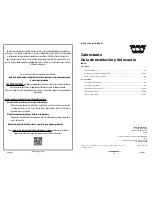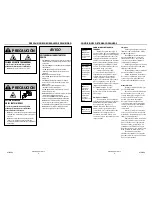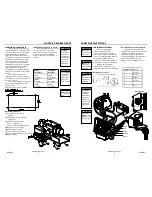
WARN INDUSTRIES * WINCH
11
OPERATING INSTRUCTIONS
WARNING
Never
engage or
disengage clutch
if winch is under
load, winch rope is
in tension or drum is
moving.
WARNING
Never
operate
winch with less
than 10 wraps of
rope around the
drum. Rope could
come loose from
the drum, as the
rope attachment
to the drum is not
designed to hold
a load.
NOTICE
Do Not power-out
rope more than 30
ft. without allowing
the winch to cool for
20 minutes before
powering rope
back in. Instead,
place the clutch in
freespool and pull
the rope off by hand.
FIRST TIME OPERATING
INSTRUCTIONS
In this section, we’ll show you the
first time operating instructions for
effective basic winch ing. For complete
winch operation and techniques read
the Basic Guide to Winching Techniques
found online at
http://www.warn.com/
corporate/literaturerequest.shtml.
Remote Control Switch
The winch is controlled by the hand
held remote control. The remote control
provides control of the power-out (forward)
or power-in (reverse) rotation of the
spooling drum
.
Do not leave the remote plugged
into the winch when not in use. Leaving
the remote plugged in, may result in
a dangerous condition and/or battery
drain.
Clutch Operation:
When the clutch is engaged, the gear
train is coupled to the winch drum and
power can be transferred from the winch
Disengaged:
Engaged:
Vertical/Horizontal Remote:
motor. When the clutch is disengaged
the drum is in the freespool position and
the gear train and winch rope drum are
uncoupled allowing the drum to rotate
freely.
The clutch lever, located on the winch
housing opposite the motor, controls
the clutch position. To prevent damage,
always fully engage or fully disengage
the clutch lever.
Spooling Out
Freespooling is generally the
quickest and easiest way to spool out
wire rope. Before freespooling wire
rope out from the winch, power out
enough rope to remove any tension the
wire rope might be under. Disengage
the clutch. Then freespool by manually
spooling out enough wire rope for
the winching operation. See
The Basic
Guide to Winching Techniques
for more
information.
Always leave at least 5 wraps of
rope on the drum.
Spooling In Under Load
Never exceed winch’s rated line
pull.
Power-in the wire rope evenly and
tightly on the drum. This prevents the
outer wire wraps from sinking into the
inner wraps, binding, and damaging the
wire rope.
Avoid shock loads when spooling,
by pulsing the control switch to take
up wire rope slack. Shock loads can
momentarily far exceed the winch and
rope ratings.
Spooling In Under No Load
Spooling with an Assistant:
Have the
assistant hold the hook strap putting as
much constant tension on the wire rope
as possible. While keeping tension, the
assistant should walk toward the winch
while you operate the control switch
spooling in the wire rope. Release the
switch when the hook is a minimum of 6
ft. (2 m) from the fairlead opening.
Spool in the remainder for storage
as directed below.
IN
OUT
WARN INDUSTRIES * WINCH
12
OPERATING INSTRUCTIONS
Spooling Out
Freespooling is generally the
quickest and easiest way to spool out
rope. Before freespooling rope out from
the winch, power out enough rope to
remove any tension the rope might
be under. Disengage the clutch. Then
freespool by manually spooling out
enough rope for the winching operation.
See
The Basic Guide to Winching
Techniques
for more information.
Always leave at least 10 wraps of
rope on the drum.
Spooling In Under Load
Never exceed winch’s rated line pull.
Power-in the rope evenly and
tightly on the drum. This prevents the
outer wraps from sinking into the inner
wraps, binding, and damaging the rope.
Avoid shock loads when spooling,
by pulsing the control switch to take up
rope slack. Shock loads can momentarily
far exceed the winch and rope ratings.
Spooling In Under No Load
Spooling with an Assistant:
Have the
assistant hold the hook strap putting
as much constant tension on the rope
as possible. While keeping tension, the
assistant should walk toward the winch
while you operate the control switch
spooling in the rope. Release the switch
when the hook is a minimum of 6 ft. (2 m)
from the fairlead opening.
Spool in the remainder for storage
as directed below.
Spooling Alone:
Arrange the rope to be
spooled so it will not kink or tangle when
spooled. Be sure any rope on the drum is
tightly and evenly layered. Spool enough
rope to complete the next full layer on
the drum. Tighten and straighten the
layer.
Repeat process until the hook is a
minimum of 6 ft. (2 m) from the fairlead
opening.
Spool in the remainder for storage
as directed below.
Spooling Remainder for Storage
When the hook is within 6 ft. (2 m) of the
fairlead, disconnect the hook from the
anchor or load. Hold onto the supplied
WARNING
Always
keep hands
clear of winch rope,
hook loop, hook and
fairlead opening
during installation,
operation, and when
spooling in or out.
WARNING
Always
use
supplied hook strap
whenever spooling
winch rope in or out,
during installation
or operation to
avoid injury to
hands and ngers.
WARNING
Always
wear heavy
leather gloves when
handling winch
rope.
WARNING
Never
touch winch
rope or hook while
someone else is at
the control switch
or during winching
operation.
hook strap and hold tension on the
winch rope. Slowly power-in the winch
by “pulsing” the power-in switch on the
remote control until the hook is within 3
ft. (1 m) of the fairlead. Stop winching in
and attach the hook to a suitable anchor
point on the vehicle.
DO NOT POWER THE HOOK INTO
THE FAIRLEAD. This could cause damage
to the fairlead. Once the hook is suitably
attached to the vehicle, power-in the
remaining slack in the winch rope by
“pulsing” the power-in switch on the
remote control until there is minimal slack
in the winch rope.
Overloading/Overheating
This winch is rated for intermittent
duty. When the motor approaches stall
speed, very rapid heat buildup occurs
which may cause motor damage.
Double-line rigging (see
The Basic
Guide to Winching Techniques
) will reduce
the amperage draw, and reduce heat
buildup in the motor. This allows longer
continual use.
87970A2
87970A2



